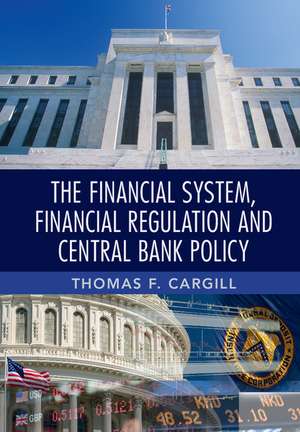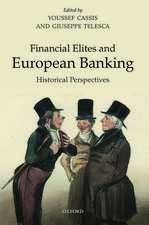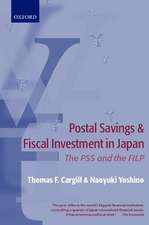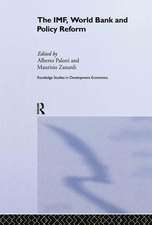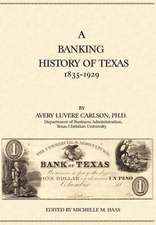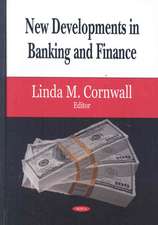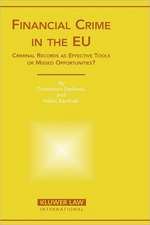The Financial System, Financial Regulation and Central Bank Policy
Autor Thomas F. Cargillen Limba Engleză Paperback – 5 oct 2017
| Toate formatele și edițiile | Preț | Express |
|---|---|---|
| Paperback (1) | 479.18 lei 3-5 săpt. | |
| Cambridge University Press – 5 oct 2017 | 479.18 lei 3-5 săpt. | |
| Hardback (1) | 792.51 lei 6-8 săpt. | |
| Cambridge University Press – 5 oct 2017 | 792.51 lei 6-8 săpt. |
Preț: 479.18 lei
Preț vechi: 538.40 lei
-11% Nou
Puncte Express: 719
Preț estimativ în valută:
91.71€ • 95.49$ • 77.50£
91.71€ • 95.49$ • 77.50£
Carte disponibilă
Livrare economică 17 februarie-03 martie
Preluare comenzi: 021 569.72.76
Specificații
ISBN-13: 9781107689763
ISBN-10: 1107689767
Pagini: 424
Ilustrații: 34 b/w illus. 45 colour illus.
Dimensiuni: 177 x 253 x 19 mm
Greutate: 0.89 kg
Editura: Cambridge University Press
Colecția Cambridge University Press
Locul publicării:New York, United States
ISBN-10: 1107689767
Pagini: 424
Ilustrații: 34 b/w illus. 45 colour illus.
Dimensiuni: 177 x 253 x 19 mm
Greutate: 0.89 kg
Editura: Cambridge University Press
Colecția Cambridge University Press
Locul publicării:New York, United States
Cuprins
Part I. Introduction to the Financial and Monetary Regime: 1. The financial and monetary regime; 2. Basic concepts regarding money; Part II. The Financial System Component of the Financial and Monetary Regime: 3. The financial system and the country's flow of funds; 4. Interest rates in the financial system; 5. The level of interest rates; 6. The structure of interest rates; 7. International dimensions of the financial system; Part III. The Role of Government in the Financial and Monetary Regime: 8. The basic roles of government in the financial and monetary regime; 9. Regulation and supervision of the financial system; 10. A short history of the US financial and monetary regime in action; Part IV. Five Steps to Understanding Central Banks and Central Bank Policy: 11. The five steps and step 1 - the institutional design of the central bank; 12. Central banks, base money and the money supply; 13. Step 2 - tools of monetary policy and step 3 - monetary policy instruments; 14. Step 4 - the central bank model of the economy; 15. Step 5 – final policy targets; 16. Monetary policy tactics, strategy and rules versus discretion; Part V. Performance of the US financial and monetary regime: 17. Four important periods in the US financial and monetary regime.
Recenzii
'This text is truly an original approach to the topic. Cargill analyses the role of markets, regulation, and monetary policy to illuminate the financial system for students. His inclusion of Public Choice Theory is innovative. He unites the work of thinkers as diverse as John Taylor and Hyman Minsky to produce a coherent analysis of the modern financial system. I highly recommend it.' Gerald P. O'Driscoll, Jr, Cato Institute, Washington, DC, and former vice president at the Federal Reserve Bank of Dallas, and Citigroup
'Professor Cargill's book offers a refreshing new look at the US financial system, regulation, and operations of the Federal Reserve System. By emphasizing political economy and historical aspects, this book encourages students to look beyond traditional macro models and into the actual formulation, working operations and limitations of financial and monetary policy.' Michael M. Hutchison, University of California, Santa Cruz
'Combining a nice mix of economic theory, institutional analysis and historical perspective, and bringing to bear a life-time of research and study, Thomas F. Cargill explains in a very comprehensive and clear way how the modern financial system works to support the real economy and how it is influenced by government regulation and monetary policy. Not only teachers and students of money and banking, but any engaged citizen wishing to bolster their financial literacy will find this authoritative volume tremendously valuable.' Paul Sheard, Chief Economist, S&P Global
'This book is a great introduction to basic concepts about money and banking in a real world context of politics and regulation. Students in my financial regulation courses will now have a non-technical book they can read as background to regulatory and policy debates.' Hal S. Scott, Nomura Professor and Director of the Program on International Financial Systems (PIFS), Harvard Law School
'Professor Cargill's new book is a welcome addition to the stock of knowledge on financial matters and monetary policy. It fills a gap in the literature in providing a condensed, accessible and yet rigorous integration of strands of literature in financial and monetary economics that are seldom presented together in a unified framework. A great effort!' Federico Guerrero, University of Nevada
'Professor Cargill has incorporated his many years of teaching and working experience in international finance and monetary markets into this textbook making it very comprehensive, succinct, and well-structured. Although with very little background on finance, I find this book captivating and very easy to understand.' Thanh Phan, Director of Marketing and Recruitment, and Executive MBA Program in Vietnam, Shidler College of Business, University of Hawai'i
'Professor Cargill's book offers a refreshing new look at the US financial system, regulation, and operations of the Federal Reserve System. By emphasizing political economy and historical aspects, this book encourages students to look beyond traditional macro models and into the actual formulation, working operations and limitations of financial and monetary policy.' Michael M. Hutchison, University of California, Santa Cruz
'Combining a nice mix of economic theory, institutional analysis and historical perspective, and bringing to bear a life-time of research and study, Thomas F. Cargill explains in a very comprehensive and clear way how the modern financial system works to support the real economy and how it is influenced by government regulation and monetary policy. Not only teachers and students of money and banking, but any engaged citizen wishing to bolster their financial literacy will find this authoritative volume tremendously valuable.' Paul Sheard, Chief Economist, S&P Global
'This book is a great introduction to basic concepts about money and banking in a real world context of politics and regulation. Students in my financial regulation courses will now have a non-technical book they can read as background to regulatory and policy debates.' Hal S. Scott, Nomura Professor and Director of the Program on International Financial Systems (PIFS), Harvard Law School
'Professor Cargill's new book is a welcome addition to the stock of knowledge on financial matters and monetary policy. It fills a gap in the literature in providing a condensed, accessible and yet rigorous integration of strands of literature in financial and monetary economics that are seldom presented together in a unified framework. A great effort!' Federico Guerrero, University of Nevada
'Professor Cargill has incorporated his many years of teaching and working experience in international finance and monetary markets into this textbook making it very comprehensive, succinct, and well-structured. Although with very little background on finance, I find this book captivating and very easy to understand.' Thanh Phan, Director of Marketing and Recruitment, and Executive MBA Program in Vietnam, Shidler College of Business, University of Hawai'i
Notă biografică
Descriere
This is a short, inexpensive textbook that teaches students the fundamentals of money and banking in a clear, narrative form.
